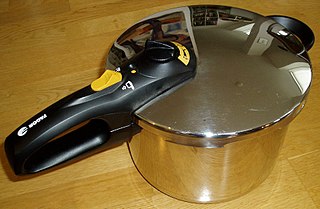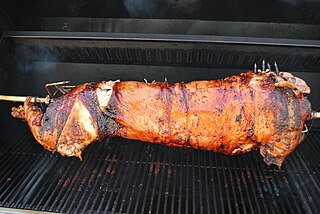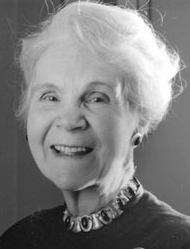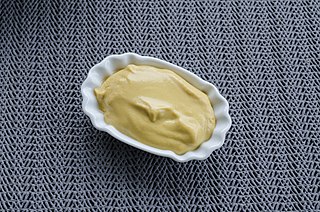Related Research Articles

Pressure cooking is the process of cooking food under high pressure steam and water or a water-based cooking liquid, in a sealed vessel known as a pressure cooker. High pressure limits boiling and creates higher cooking temperatures which cook food far more quickly than at normal pressure.

Roasting is a cooking method that uses dry heat where hot air covers the food, cooking it evenly on all sides with temperatures of at least 150 °C (300 °F) from an open flame, oven, or other heat source. Roasting can enhance the flavor through caramelization and Maillard browning on the surface of the food. Roasting uses indirect, diffused heat, and is suitable for slower cooking of meat in a larger, whole piece. Meats and most root and bulb vegetables can be roasted. Any piece of meat, especially red meat, that has been cooked in this fashion is called a roast. Meats and vegetables prepared in this way are described as "roasted", e.g., roasted chicken or roasted squash.

A microwave oven or simply microwave is an electric oven that heats and cooks food by exposing it to electromagnetic radiation in the microwave frequency range. This induces polar molecules in the food to rotate and produce thermal energy in a process known as dielectric heating. Microwave ovens heat foods quickly and efficiently because excitation is fairly uniform in the outer 25–38 mm(1–1.5 inches) of a homogeneous, high-water-content food item.

Searing, or pan searing is a technique used in grilling, baking, braising, roasting, sautéing, and the like, in which the surface of the food is cooked at high temperature until a browned crust forms. Similar techniques, browning and blackening, are typically used to sear all sides of a particular piece of meat, fish, poultry, etc. before finishing it in the oven. To obtain the desired brown or black crust, the meat surface must exceed 150 °C (300 °F), so searing requires the meat surface be free of water, which boils at around 100 °C (212 °F).

A slow cooker, also known as a crock-pot, is a countertop electrical cooking appliance used to simmer at a lower temperature than other cooking methods, such as baking, boiling, and frying. This facilitates unattended cooking for many hours of dishes that would otherwise be boiled: pot roast, soups, stews and other dishes.

A convection oven is an oven that has fans to circulate air around food to create an evenly heated environment. The increased air circulation causes a fan-assisted oven to cook food faster than a conventional non-fan oven, which relies only on natural convection to circulate the hot air. Fan-assisted convection ovens are commonly used for baking as well as non-food, industrial applications. Small countertop convection ovens for household use are often marketed as air fryers.

Joy of Cooking, often known as "The Joy of Cooking", is one of the United States' most-published cookbooks. It has been in print continuously since 1936 and has sold more than 20 million copies. It was published privately during 1931 by Irma S. Rombauer (1877–1962), a homemaker in St. Louis, Missouri, after her husband's suicide the previous year. Rombauer had 3,000 copies printed by A.C. Clayton, a company which had printed labels for fancy St. Louis shoe companies and for Listerine mouthwash, but never a book. Beginning in 1936, the book was published by a commercial printing house, the Bobbs-Merrill Company. With nine editions, Joy of Cooking is considered the most popular American cookbook.

A solar cooker is a device which uses the energy of direct sunlight to heat, cook or pasteurize drink and other food materials. Many solar cookers currently in use are relatively inexpensive, low-tech devices, although some are as powerful or as expensive as traditional stoves, and advanced, large scale solar cookers can cook for hundreds of people. Because they use no fuel and cost nothing to operate, many nonprofit organizations are promoting their use worldwide in order to help reduce fuel costs and air pollution, and to help slow down deforestation and desertification.

Sous vide, also known as low-temperature, long-time (LTLT) cooking, is a method of cooking invented by the French chef Georges Pralus in 1974, in which food is placed in a plastic pouch or a glass jar and cooked in a water bath for longer than usual cooking times at a precisely regulated temperature.

Irma Rombauer was an American cookbook author, best known for The Joy of Cooking (1931), one of the world's most widely read cookbooks. Following Irma Rombauer's death, periodic revisions of the book were carried out by her daughter, Marion Rombauer Becker, and subsequently by Marion's son Ethan Becker. The Joy of Cooking remains in print, edited by members of the Rombauer–Becker family, and more than 18 million copies have been sold.

Scalding is a form of thermal burn resulting from heated fluids such as boiling water or steam. Most scalds are considered first- or second-degree burns, but third-degree burns can result, especially with prolonged contact. The term is from the Latin word calidus, meaning hot.
Scalded milk is dairy milk that has been heated to 83 °C (181 °F). At this temperature, bacteria are killed, enzymes in the milk are destroyed, and many of the proteins are denatured. Since most milk sold today is pasteurized, which accomplishes the first two goals, milk is typically scalded to increase its temperature, or to change the consistency or other cooking interactions due to the denaturing of proteins.
Low-temperature cooking is a cooking technique that uses temperatures in the range of about 60 to 90 °C for a prolonged time to cook food. Low-temperature cooking methods include sous vide cooking, slow cooking using a slow cooker, cooking in a normal oven which has a minimal setting of about 70 °C (158 °F), and using a combi steamer providing exact temperature control. The traditional cooking pit also cooks food at low temperature.

Shrimp creole is a dish of Louisiana Creole origin, consisting of cooked shrimp in a mixture of whole or diced tomatoes, the “holy trinity” of onion, celery and bell pepper, spiced with hot pepper sauce or cayenne-based seasoning, and served over steamed or boiled white rice. The shrimp may be cooked in the mixture or cooked separately and added at the end. Other "creole" dishes may be made by substituting some other meat or seafood for the shrimp, or omitting the meat entirely.

Stuffed peppers is a dish common in many cuisines. It consists of hollowed or halved peppers filled with any of a variety of fillings, often including meat, vegetables, cheese, rice, or sauce. The dish is usually assembled by filling the cavities of the peppers and then cooking.

Hallongrotta is the name of a common Swedish cookie. The name means raspberry cave in Swedish. In the United States they are known as thumbprint cookies, as well as by many other names. Similar cookies sold in Australia are known as jam drops.
In cooking, a matignon is a mirepoix in which the ingredients are minced rather than diced, and more flavorings added. Matignon, unlike mirepoix, is not a part of the food preparation itself, but is always served at the table.

Ganache is a glaze, icing, sauce, or filling for pastries, made from chocolate and cream.

Mustard is a condiment made from the seeds of a mustard plant.

Marion Rombauer Becker was an illustrator, author, environmentalist, and arts administrator. She is best known for her work illustrating the original The Joy of Cooking, which she co-authored with her mother Irma von Starkloff Rombauer, and continued to update after her mother's death.
References
- 1 2 SI Units:Temperature. NIST Physical Measurements Laboratory. 5 June 2019. Retrieved 28 July 2019.
- ↑ Irma S. Rombauer; Marion Rombauer Becker; Ethan Becker (1997). Joy of Cooking. Simon and Schuster. p. 1074. ISBN 978-0-684-81870-2.
- ↑ Carlotta Cherryholmes Greer (1920). School and Home Cooking. Allyn and Bacon. pp. 330–333.
- ↑ Irma S. Rombauer (1946). The Joy of Cooking. Bobbs-Merrill. p. 447.